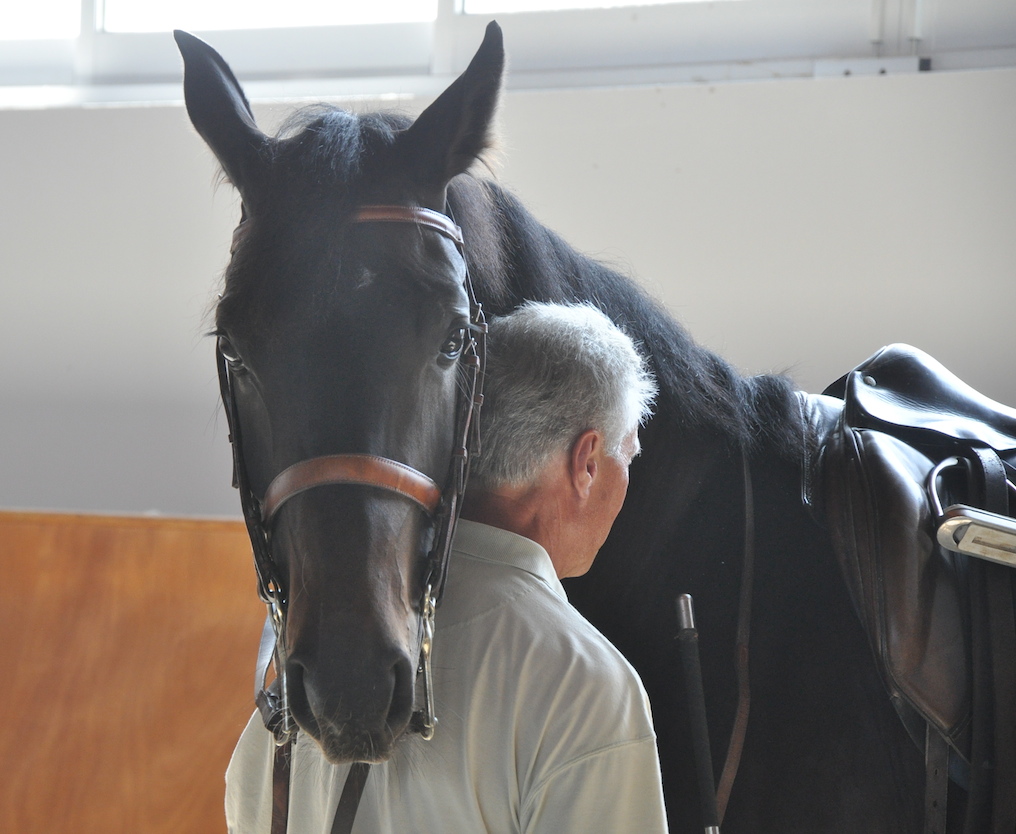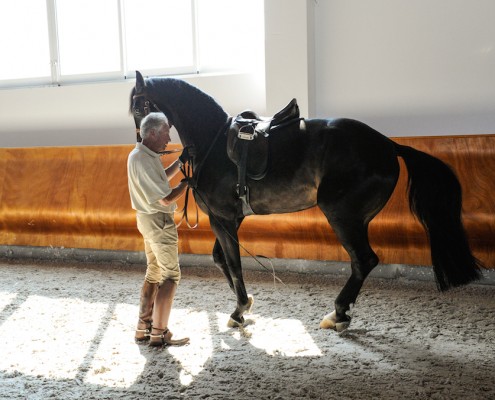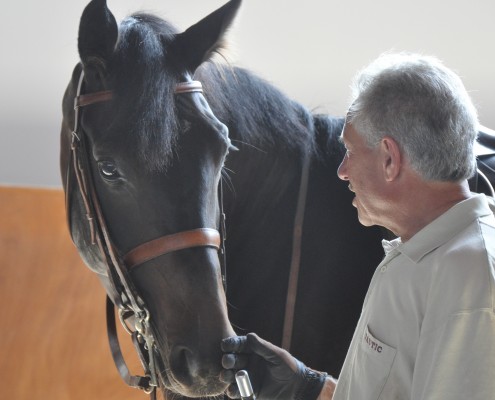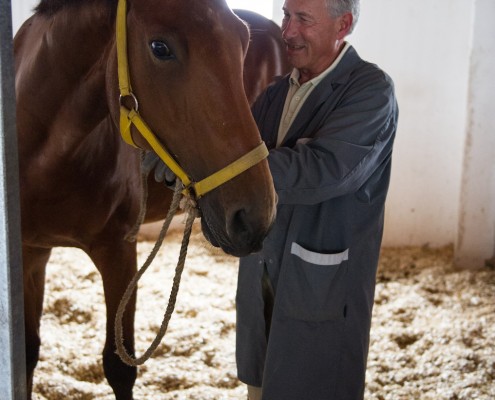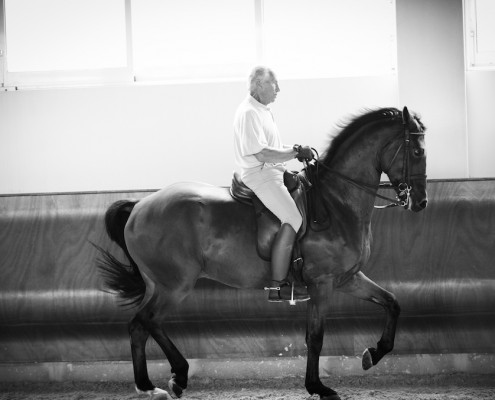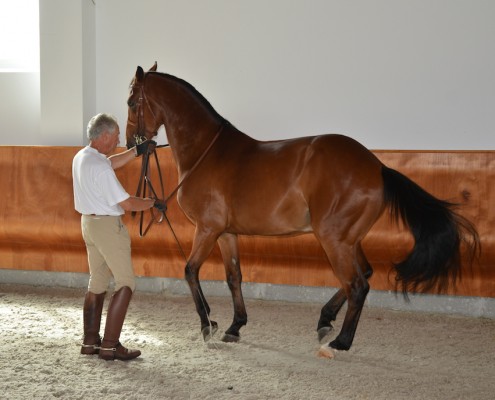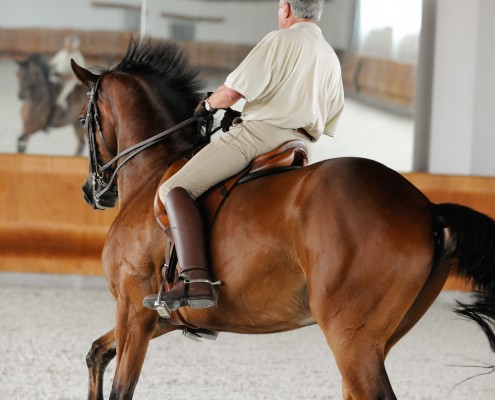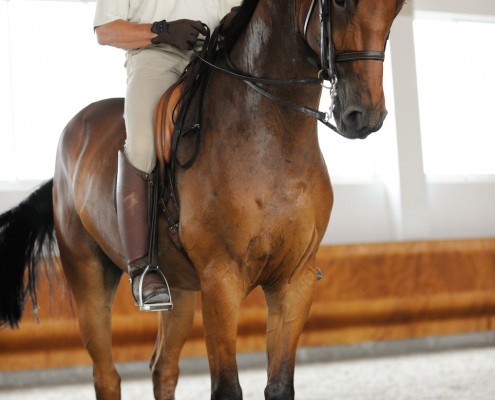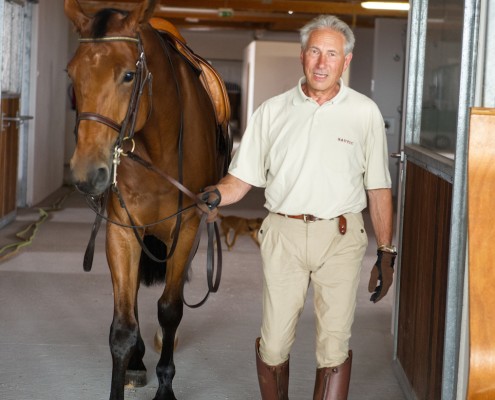Interview with Anton Walliser
Anton Walliser arrived in Portugal about 15 months ago from France but in fact, he is Swiss. He is an original, inventive and creative individual who still has his family business in Switzerland where he invents precision tools. He is also a dentist and cranial sacral therapist.
Well dressed, self disciplined, strongly opinionated he makes for an interesting traveling and dinner companion. Debates and discussions are always fascinating, sometimes challenging – never boring.
Now at close to 70 years old Anton is devoting much of his time to his horses. He works daily with 4 spirited hot young horses. It’s clear to me he passionately loves the work he does and having spent time with him, observed him work each horse I would confidently call him a ‘Classical Master’. He currently has 3 warm bloods one at GP level and the other two will come to GP. In addition he has bought his first Lusitano – which we traveled the length and width of Portugal to find.
Gifted with a fine eye for a potential Top Horse
There is no doubt he has a fine eye for a horse and is extremely precise about what he is looking for. The result has meant that all horses personally trained by Anton have achieved Grand Prix Dressage.
Anton Walliser
Anton Walliser and his mare
Although a classical approach to his work Anton is passionate about International Dressage Competition
and so wants to see his horses competing. He teaches all his equines by himself from grooming, washing to all ground and ridden work. His horses adore him. You only have to accompany Anton to the yard, witness the reaction to his presence to become acutely aware of just what an exceptional bond he has with each one of his horses.
I met Anton at a party in December 2013 and we quickly became friends. He was interested to learn more about Lusitanos and hoped to purchase one. So we began traveling Portugal in search of a colt. Finally we found the one at Coudelaria Vila Viçosa – there was no doubt in either of our minds the moment the young colt began to trot he was the one Anton had been searching for.
`Unsung Classical Master’
I find Anton to be an ‘Unsung Classical Master’ with valuable gifts to share and he is willing to share them. He is straightforward and holistic in his approach to his work. Believing wholeheartedly that in life ‘less is more’, he says we must avoid complicating situations and look to ourselves to find solutions. He went onto tell me that he thinks people have become too obsessed with gadgets and quick fix solutions, life is more simple and that working with horses is very special experience.
All horses deserve time and respect, they will become a reflection of us so it is vital that we are mindful of how we act.
I am delighted to be able to share with you more about Anton’s working philosophy and ideals in this interview.
Anton how long have you been riding and with whom did you train?
I began to ride when I was 15. At that time I was in my military service and at EMPFA where I was very fortunate to have very good trainers. I showed promise and was given the chance to be trained in the federal stud in Avenches by the chief dressage rider and international dressage judge Guinchard.
After this I went on to train with other well-known riders – Henry Chammartin, Georg Wahl and especially with his daughter, who was a very talented teacher. Later I worked with with Egon v. Neindorff and some other famous German riders.
However it is fair to say four of my most profound teachers were the schoolmaster horses I rode, all of them were at Grand Prix level. They were my greatest masters.
Who do you admire most in their riding and equine skills?
My favorites are : Henry Chammartin, Rainer Klimke, Edward Gal, Isabel Werth
I understand you have brought several horses to Grand Prix dressage can you tell us a bit about your training philosophy.
I once bought was a beautiful 4 year old Danish Trakehner, called Copernicus. I taught Copernicus myself to Grand Prix without any help. He was an extremely hot gelding that was both hugely challenging and rewarding for me. Copernicus was capable of a great Piaffe and his flying changes were excellent. He made me very proud. He was the start of my work alone with horses.
My Philosophy
My training philosophy is about giving the horse time and space to gain confidence in his work and develop a solid base. The programme I work to is designed to allow each horse to understand without any pressure what I am asking at each step of the way. Everything should be calm and soft avoiding all stress. I do a lot of in-hand work especially at the very start but also all through their training. Although it becomes less as they get older, I never cease the work from the ground.
My horse’s educational work starts in the stable and in grooming, where I teach them to put themselves standing square with just a few words I teach them to respond to. I firmly believe in grooming horses and handling them myself to and from stable and paddock. It is, at these times I’ve witnessed many things about my horses – it can help me in my future work with them. All my horses no matter how hot they are, are extremely soft and respectful to be around and handle.
Anton, I am particularly impressed with the in hand work you do and the amount you do. How did you learn all this? Tell us a bit more about it.
My in hand work is a mix of working on lunge with two lines, long lining, lateral and moving forward backing up, standing square. I think many people do a certain amount of work on lunge and even long lines before they ride the horse, but few do the amount and variation I do. From the in hand work I can confidently assess when each horse is ready ride – by the time I get on the horse it is actually is simply another stage for them. They think very little of it as they have total confidence and trust in me. I do this alone. This is my personal choice and I don’t say getting on alone is right for everyone.
In beginning lateral work I prefer to teach young horses the half pass in long lines from behind it is easier than teaching the shoulder in. I feel it frees the shoulder much more. It also educates them to understand the ease of movement and control in the shoulder ready for when I ask it when I am on top. My horses learn all lateral movements, piaffe and passage in hand even changes are possible. Since they know all this when this moment comes ridden to attempt the movement, the horse is able to learn very fast. Naturally, the first results are not spectacular but the horse understands without any stress. For example my current 7 year old Hanovarian called Cuba Libre, started learning from 5 years all Grand Prix lessons, he achieved it in 2 years. Now everything is in place we can work together to develop the expression, improvement of everything and ongoing physical and mental training to give him the ability to do his work in obedience and lightness.
Working without Stress
I believe that when teaching horses new movements that it is not about getting the perfect exercise it is simply about achieving the movement together without any stress so the horse understands what is being asked. The expression and precision come later when they are more physically mature. This approach means all my horses stay very soft, supple and elastic their muscle development is smooth without bulk.
Early Days
In my early days I did a lot of carriage driving. Even a Grand Prix horse had to drive in front of a buggy. The result was spectacular: piaffe, passage, transitions, extended trot and a kind of half-pass in the corners with long reins from the buggy! I was so convinced by this experience that I followed and developed this idea to how I am working today. This influenced my work on lunge with two lines.
Anton Walliser
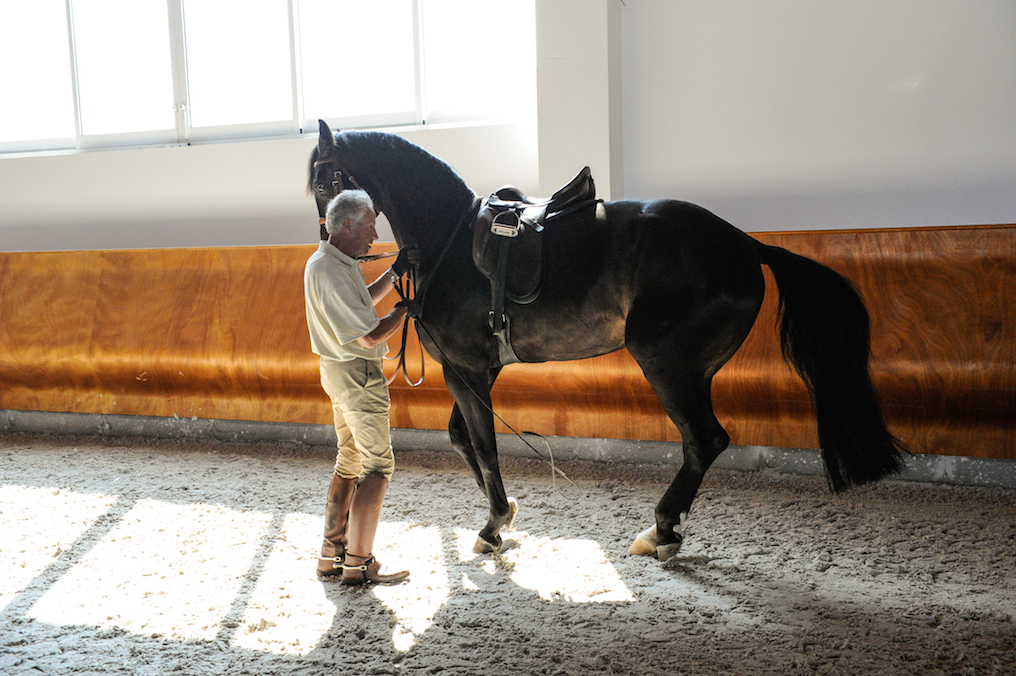 Anton Walliser
Anton Walliser
The piaffe is something you trained fantastically from the ground. Nowadays the piaffe is vital in dressage competition and riders are always looking to different ways to teach it. I would love to know more about your thoughts on the piaffe and teaching it well.
For most of the horses at Grand Prix level the piaffe is one of the most difficult lessons. But compared to 20 years ago, I think more and more horses are showing a good piaffe, and even some with a superb piaffe. I think this is due to the progress in breeding coupled with more and more trainers knowing how to teach the horse. In my opinion, the best way to teach the horse is to take a very individual approach for each horse, they are all different. There are a lot of possible ways to achieve a good result. It is simply a matter of understanding the horse you are working with and using the approach that works best for them.
Most of the time I teach the horse piaffe in hand as you can see on the video with Frimousse at 5 years old.
It is fair to say nearly all horses can learn a kind of piaffe however, the number of horses that will be able to show an exceptional piaffe is limited. Rare are the horses worth the time to invest that will make an excellent piaffe. Of course if all horses could do it to perfection maybe Grand Prix would not be the competition that it is.
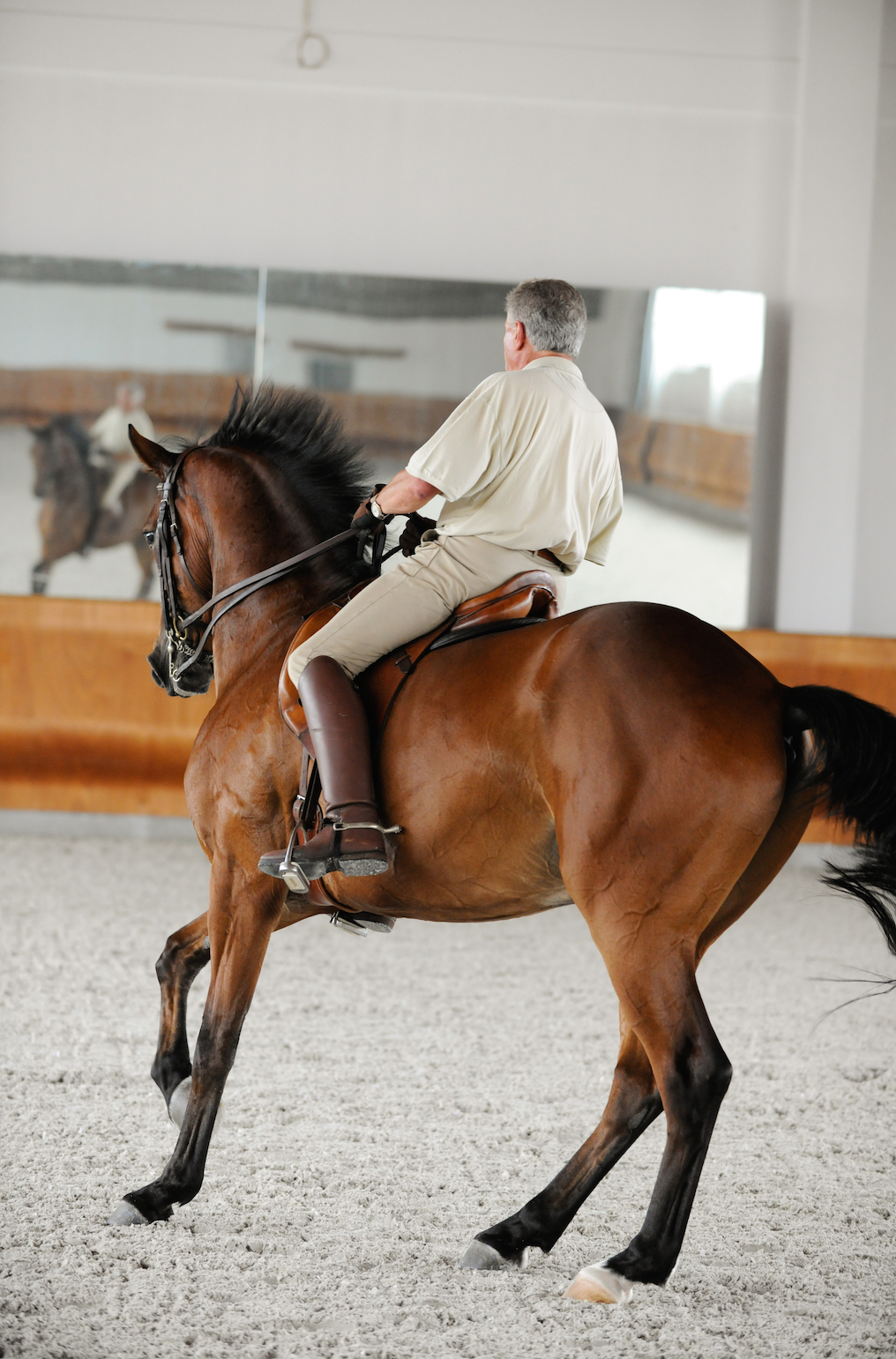 Can you talk a bit about canter changes especially 2 time and one time changes how do you train them. Yours are wonderfully straight and up hill . I have notice a real difference in your body position compared to many you lean back and ask the changes through your hips whereas many riders are swinging their bodies from one side to the other to achieve the movement.
Can you talk a bit about canter changes especially 2 time and one time changes how do you train them. Yours are wonderfully straight and up hill . I have notice a real difference in your body position compared to many you lean back and ask the changes through your hips whereas many riders are swinging their bodies from one side to the other to achieve the movement.
In flying changes I am always mindful of the words of General La Hotte: straighten your horse and go ahead! My preferred exercise to teach the flying changes up to every stride is on the big circle. It is easier to push the horse forward when asking the flying change and to keep him under control, because he never knows the moment we are asking to do so. To make the change really straight and uphill is only possible with a horse when he has learnt to canter fully balanced under and into the hand of the rider. I don’t like to see riders swinging so much from one side to the other I cannot see how a horse can achieve perfectly straight changes with the added problem of riders weight shifts. I always ask for the changes through my hips and leaning back slightly helps me to free my hips to achieve this it also allows the horse to be more expressive in front and up hill.
Classical 3 to 1 method to Holding the Double Reins (3 to 1 Rein Hold)
Anton I have noticed when you are riding with a double bridle you are using the classical method of three and one for holding the reins. I think that this technique is the oldest method of holding double reins a style used by the Spanish Riding School in Vienna and by many of Germany’s most successful professional riders used it before WWll.
How the reins are held –
The left hand holds three reins, while the right holds only one rein plus the rider’s cane or whip. The correct placement of reins in the left hand is to hold the left snaffle on the outside of the little finger, the left curb rein between little finger and ring finger, and the right curb rein between the ring and middle fingers. The right hand holds the right snaffle rein in the traditional position between the right little finger and ring finger. The left hand is held more to the center of the horse directly over the withers than off to the left of the withers.
As I understand when using this method it decreases the action of the curb, prevents the rider from riding with their hands too wide and it shows when the horse is not properly straight, because the rider can no longer make the rein pressure on one side of the mouth any stronger than the other, since reins from both sides are held in the left hand. The rider must ride off the seat and legs to bend the horse, and the horse must therefore be properly “through”.
Would you agree with this Anton? Can you add why you are using this method.
Yes I basically agree with your description of the 3 to 1 method. I find it to be a far more effective method in training horses. 20-30 years ago Swiss and German riders were competing their horses using this way but nowadays I don’t see anyone using it.
Why do you think that is?
It is much more difficult to learn than the 2 to 2 method used by everyone today. Learning it takes a lot of practice and patience but the results speak for them self – horses and riders progress much better. It really helps in training your horse to be straight, you have an even contact on the curb, never any sudden movements of jerking the curb. The hands are much more together, much quieter and certainly you are riding far more with seat and legs. The horse bends better round your leg your seat will be quieter. The horses stay lighter and more through. I don’t know where this method started but I think it is sad that it is rarely seen used nowadays because if mastered the technique is far better for horse and for the rider.
Anton what do you consider to be fully rounded training, in order for a horse to develop in the best possible way – from training to care and nutrition.
The basic condition for a fully rounded training programme is to have time for the horse, to respect him as a partner, to give him the necessary attention by taking care of him and let him enjoy an adapted nutrition and a good stabling – not a prison. Time in liberty in a paddock, diversity in training and hacking out are fundamental. Successful training is based on knowledge, skillfulness and talent.
Recently I have been used my training in cranial sacral therapy on my horses and I’ve noticed some real differences my mare had some blockage in her neck which with this gentle work has completely released her and she is going better than ever. I do a little most days with all of them. I think this type of light touch and manipulation is more effective than heavy, sudden manipulation treatments.
You keep all your horse bare foot and trim their feet yourself – what are you thoughts on this?
My horses don’t need shoes because outside the facilities they are not hacking through rough grounds. To take care of the hoofs and to trim them asks the rider always to pay attention to the feet and to check them every day. A hoof without shoes becomes very hard and is able to enjoy full natural functionality and better blood circulation. My horses perform extremely well and expressively without shoes so I honestly cannot see why interfering with their balance and comfort or adding any restriction to the natural blood flow in the hoof is of benefit. I realise saying this may upset some but I have recently read that a few well known International riders are thinking the same way and want to go barefoot to competition.
I know that you love dressage competition and keep very up to date with all that is going on. Tell me what do you think of dressage competition today?
What we see in dressage competition nowadays is a larger range concerning the results than ever before. Most of the competitors are in the medium marks, but more and more riders are going over 70% to approach 80% or even more! This means that the difference between the weakest and the best in a competition is always getting bigger. The best are playing on such a high level that it is easy to understand that the spectators are only interested to observe and enjoy the best.
This certainly highlights a problem and a point to find a solution to give more appeal to the dressage sport at all levels and for spectators to appreciate other levels. Everyone should be encouraged to enjoy and participate in the sport, it brings so many rewards.
Anton we have traveled together a lot, visiting many studs to look at Lusitanos, can you give me you thoughts on the breed having now seen many.
We have certainly seen a lot of normal and very typical Lusitanos corresponding ideally to what most Lusitano buyers ask: good character, good mind, intelligent, beautiful and impressive, not to forget the wonderful colours. As we had been more focused on high level dressage Sport Lusitanos, we did not come across such a big choice. They are rare and difficult to find. I think that especially for these Sport Lusitanos the breeders have to be very careful not to lose the typical Lusitano aspect when trying to achieve better gaits and match the warm blood movement.
I think the young Lusitano I have is an super example of how breeders should be breeding more sportive Lusitanos he has all the qualities of the true Lusitano in model, he is powerful, is elastic and with quality gaits that compare the warmbloods.
The aim is certainly to breed a typical Lusitano with warmblood gaits: The Sport Lusitano.
What key things do you look for when choosing your next potential GP horse?
My key qualities are:
- Good basic gaits – good activity in hind leg and suspension
- Health
Potential
Character
Temperament
I do feel that Anton’s answer to this question gives away very little in exactly how he chooses a horse but maybe it is because in addition to the list above he has an instinct for the right one – having spend time with him in many yards I felt very strongly that there is a lot more going. He sees tiny details in the behaviour of the horse and in the movement and character, details that are easily missed or not considered. I know from my experience with assisting people to find a horse it’s an extremely personal and sometimes emotional process. If you see the horse that is destined to be your equine partner, often the ‘normal’ rules don’t apply, many are motivated by something more personal, a connection. Many times I’ve heard the expression ‘the horse picked me’ maybe this is true.
You currently have 3 warm bloods in training and your first Lusitano can you tell us a bit about any difference you’ve noticed in the working with the Lusitano compared to warm bloods.
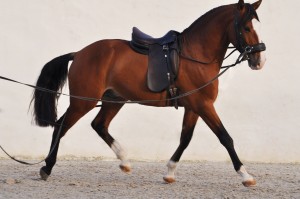 It is to early to talk seriously about this difference. All the four horses of my current horses are such special individuals. They have been very carefully selected by me. I buy horses that the do not reflect the potential medium level dressage. I look for horses that have potential for well over 70%.
It is to early to talk seriously about this difference. All the four horses of my current horses are such special individuals. They have been very carefully selected by me. I buy horses that the do not reflect the potential medium level dressage. I look for horses that have potential for well over 70%.
I will be able to make a good comparison when all the horses are the higher educated. However I will say I am finding An-Gola (formerly Guizo) quick, willing and intelligent. Once something is taught he never forgets. He is always very engaged in his work.
He arrived with me October last year, he was still relatively un-handled. A bit wild in fact as he was straight from his colt herd to me with just a couple of weeks in a stable at the stud. It was the first time I have started with such clean slate. He adapted very quickly and thoroughly enjoys working – he always wants to be first.
Guizo (now know as An-Gola) when we first saw him in July 2014, after this video he went back to the fields until October 2014 when he was received by Anton.
I’ve been teaching him on two lines in lunge work and walking behind him. I first got on his back in December now just ride him occasionally. I’m in no hurry the most important thing is he enjoys working and understand in a stress free way all I ask of him.
An-Gola in training March 2015
I noticed when you rode him for me that you didn’t have the reins attached to the bit why was this?
Although I teach all my horses from the start to work with a bit in the mouth I don’t really believe in putting any pressure on the mouth so I never attach the reins to the bit in lunging, long lining. Even when I am first riding I attached the reins to the cavesson. I move to the bit later when each horse is working in a relaxed forward way.
An-Gola March 2015
What is your aim now with your horses?
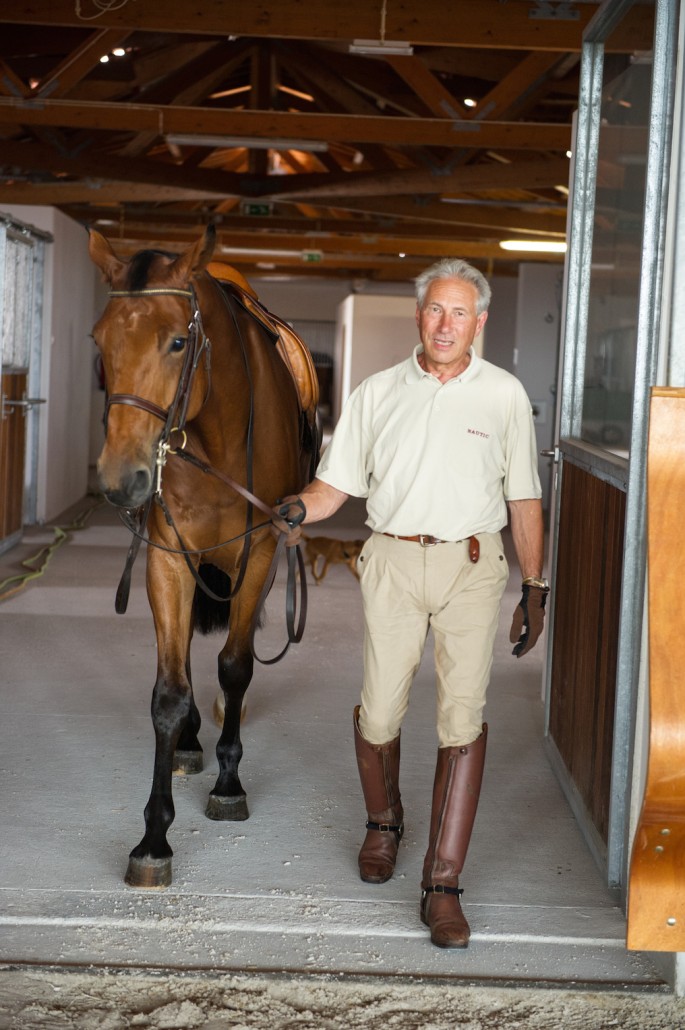 I would like to bring each of them to the highest level possible. As I no longer want to compete I am looking for interested riders to eventually buy them and compete Internationally. My joy is the journey and eventually finding perfect competitions partners for them, this gives me real pleasure.
I would like to bring each of them to the highest level possible. As I no longer want to compete I am looking for interested riders to eventually buy them and compete Internationally. My joy is the journey and eventually finding perfect competitions partners for them, this gives me real pleasure.
Cuba Libre is now ready to be a competition horse. I competed him for the first time a couple of weeks ago in PSG he scored 66% of which I was pleased with especially as we only had 20 minutes preparation time and many scores were 8’s. He broke in the extended trot and thus we got a low score for this. He is now available for people to see and try I know he will be amazing competition horse and will easily score well into 70’s. I am excited for his future. – He is demonstrating a super piaffe, his one times are fantastic and his lateral work will always score 8 or more. I am also excited for me to be able to enjoy following his career.
Please ask people to contact you if they are interested to try him he is a horse for a professional rider.
Big Thanks for the Insight and Inspiration
Anton, I always feel very blessed to spend time with you, see your beautiful horses. I sincerely hope that others will seek you out and discover the depths you have began to reveal to me. I admire that you are not swayed by critics, or judgements of others or gadgets or the latest fads. You remain true to your values and your horses truly reflect this, indeed they positively jump for joy when they see you.
Thank you so much for a thoroughly interesting conversation. I look forward to seeing your horses progress and spending more time with you.
If you want to know more or see his horses, receive videos and details please message me Teresa
CREDITS – Editorial Interview- Teresa Burton Photography – Lena Saugen Photography (excluding images of An-Gola)

